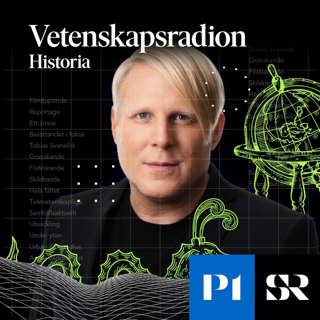
63. Ingredients of Defeat
What led to the British defeat in North America? Was it a battle at Yorktown in Virginia, brilliantly won by George Washington and the Count of Rochambeau's American and French armies? And did that victory at Yorktown immediately lead to US independence? This episode sets out to give the context to Yorktown and reinterpret the common narrative about the Franco-American victory. Essential to a new understanding is to take into account that Britain was no longer fighting just a war in America, but another world war, after the Seven Years' War. This time, though, a decade and a half of ill-planned economy measures had left the country desperately badly prepared to fight it. That, more than any one battle, even as disastrous a defeat as Yorktown, made it inevitable that Britain would lose its American colonies. Illustration: The Battle of the Chesapeake (sometimes called the Battle of the Virginia Capes). Public domain. Music: Bach Partita #2c by J Bu licensed under an Attribution-NonCommercial-No Derivatives (aka Music Sharing) 3.0 International License
28 Okt 202114min

62. Divorce
The revolting Americans, by the time of this episode, have decided they’ve had it right up to here with the Brits. It’s time to part company. So they adopt a Declaration of Independence, basically serving divorce papers on the Mother Country. Which refuses to sign them, of course, ensuring that the ugly dispute lasts another few years. As for that dispute, it goes on with the advantage swinging from one side to the other. William Howe wins a couple of victories over the still inexperienced Washington, but fails to follow them up. Washington gets good at dodging destructive defeats and keeping the cause alive. But then, to everyone’s surprise, he even wins a couple of impressive victories. Then the Brits launch a cunning scheme to win a decisive victory, which goes colossally wrong, leading to their worst defeat of the war, at Saratoga. Meanwhile, back in England Pitt is still trying to persuade his countrymen to take a more sensible stance. “Conquering America is impossible,” he tells them, but they aren’t listening. Then, when a voice is raised in Parliament for the recognition of American Independence, he pretty much dies opposing it – it actually takes him nearly five weeks to die, but the attack from which he failed to recover hit him in the House of Lords, while he was struggling to speak out. A nasty divorce. With plenty of fighting. And a lot of bad blood on the way. Illustration: Portrait of George Washington by Gilbert Stuart, 1796. National Portrait Gallery 2001.13. Music: Bach Partita #2c by J Bu licensed under an Attribution-NonCommercial-No Derivatives (aka Music Sharing) 3.0 International License
22 Okt 202114min

61. None so deaf
Enjoy the words of two remarkable people in England who battled on for the cause of conciliation between the home country and the colonists in America. Neither was listened to. This was a time when many in Britain wanted only to turn a deaf ear to the Americans and their concerns. Meanwhile, back out there, General Gage was still in command of a military force occupying Boston. He decided it was time to use his military force militarily and sent troops to two Massachusetts villages that have since entered American legend. They are Lexington Green and Concord. While they were there, a hostile confrontation led to a shot being fired, and we were off: what had been a war of words became a shooting war. It started badly for the British. We’ll discover soon that it would end just as badly. But it would take some seven years. Illustration: Portrait of Edmund Burke from the studio of Joshua Reynolds, circa 1769. National Portrait Gallery 655. Music: Bach Partita #2c by J Bu licensed under an Attribution-NonCommercial-No Derivatives (aka Music Sharing) 3.0 International License
19 Okt 202114min

60. Things go south under Lord North
It’s time for that exciting moment in American (and British) history, the Boston Tea Party. But tea, as well as being a commodity deeply rooted in the British soul, is also a wonderful link between the two wings of Britain’s growing Empire, India and North America. In India, of course, power was still being exercised by the East India Company. That had disastrous results in the subcontinent, and a corrupting effect in Britain. But the government found itself powerless to do anything about it, while the Indian people, especially of Bengal, suffered tragically. As for North America, that was where the East India Company, then going through lean times, was hoping that exports would help it rebuild its fortunes. Tea was to be the product that would do the trick. But in fact, it only led to another grinding step downwards in relations between mother country and colonies, one that brought closer the approaching disaster (for Britain). Illustration: Boston Tea Party. Original uploader was Cornischong at lb.wikipedia - Source:W.D. Cooper. ‘Boston Tea Party’, The History of North America. London: E. Newberry, 1789.Engraving. Plate opposite p. 58. Rare Book and Special Collections Division, Library of Congress. Transferred from lb.wikipedia Music: Bach Partita #2c by J Bu licensed under an Attribution-NonCommercial-No Derivatives (aka Music Sharing) 3.0 International License
8 Okt 202114min

59. The Americans are revolting
The moment has arrived. The Americans are, at last, revolting. And it was far from inevitable. What made sure it would happen was the brainlessness of British leaders, most specifically in this episode, General Thomas Gage in America and Lord North in London. Gage landed troops in Boston to restore order. But putting an army amongst a resentful civilian population was never going to end well. And it didn’t. The killing of a child and then the event that came to be known as the Boston Massacre kept the resentments alive. But still a spark was needed. And that would be provided, as we’ll see in the next episode, by Lord North. Illustration: The Landing of British troops in Boston, 1768. Public domain Music: Bach Partita #2c by J Bu licensed under an Attribution-NonCommercial-No Derivatives (aka Music Sharing) 3.0 International License
1 Okt 202114min

58. Digging the hole deeper
Faced with deepening and increasingly violent resistance to its rule in the American colonies, Britain's new Prime Minister, the Marquess of Rockingham, repealed the Stamp Act that had excited so much anger. William Pitt, in particular, spoke out forcefully against that Act, and Benjamin Franklin warned British parliamentarians of the difficulties ahead. However, Rockingham and even Pitt, still believed that Britain had the right to impose its will on the colonies. Repeal of the Stamp Act was followed up two months later by passage of the Declaratory Act, asserting British control in America, at just the time when that control was beginning to unravel. With its back to the wall, Britain was clearly unable to read the writing on it. Note and apology: To anyone who listened to the first version of this episode: it incorrectly stated that William Pitt the Elder had already been raised to the House of Lords as Earl of Chatham when he spoke for the repeal of the Stamp Act. In fact, that didn't happen until later the same year. I've corrected the episode to remove that error. Illustration: Rockingham, the Prime Minister who repealed the Stamp Act, but then passed the Declaratory Act asserting Britain’s control over the colonies. After Sir Joshua Reyonolds, ca 1768 National Portrait Gallery 406 Music: Bach Partita #2c by J Bu licensed under an Attribution-NonCommercial-No Derivatives (aka Music Sharing) 3.0 International License
29 Sep 202113min

57. Sons of Liberty
The British government of the 1760s couldn’t complain that nobody had warned it of the catastrophic consequences of trying to inflict taxes on the American colonists, without their consent. 'American' was increasingly the right word for them, as various forces, including non-English immigration, began to change the nature of the population. Even so, they remained for the most part wedded to their British roots. Their anger at the government’s behaviour wasn’t just a rejection of British highhandedness. On the contrary, many of them spoke out as Brits against Britain’s trampling on long-established British rights they saw themselves as defending. It wasn’t just the American-British of the colonies speaking out. There were voices in Britain itself defending their cause. One of the more remarkable was that of self-made soldier and MP, Isaac Barré. An interesting man to get to know, as we do in this episode. Illustration: Portrait of a passionate spokesman for the American colonists: Isaac Barré by Gilbert Stuart, ca 1785. National Portrait Gallery 1191 Music: Bach Partita #2c by J Bu licensed under an Attribution-NonCommercial-No Derivatives (aka Music Sharing) 3.0 International License
22 Sep 202114min

56. Taxing times
Lord Bute, as Prime Minister, did what he could to attack the British public debt by reducing costs. But there were limits to how far he could go. Eventually, he needed to raise taxes too. With his Chancellor of the Exchequer, Pitt’s former friend and now political enemy George Grenville, he pushed through a tax on cider. Then, after Bute fell and was replaced by the same Grenville, it was time to try taxing the American colonists. There were widespread objections to the Sugar Tax, but eventually it was grudgingly accepted and generally paid. Sadly, Grenville couldn’t simply accept that small win. He overreached with another tax he thought was an exceptionally smart move: the Stamp Act. And with that he effectively drove the first nail into the coffin of Britain’s imperial position in North America. Illustration: George Grenville, the ‘Gentle Shepherd’, published by Richard Houston, after William Hoare, circa 1750-1775 National Portrait Gallery D20047 Music: Bach Partita #2c by J Bu licensed under an Attribution-NonCommercial-No Derivatives (aka Music Sharing) 3.0 International License
10 Sep 202114min




















